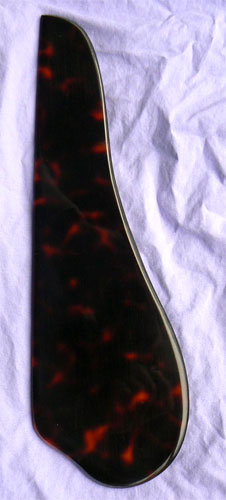
09-30-2020, 12:44 PM
|
|
Registered User
|
|
Join Date: Mar 2013
Location: Staten Island, NY - for now
Posts: 15,048
|
|

Quote:
Originally Posted by Dave Richard

I have here in my shop, a ‘47 Blackstone, with the same inlay (not the stickpin)...
|
Not surprising in the least as instruments in the immediate postwar period were often assembled from existing stocks and, if a Zenith overlay was available, it might well have been fitted to a Blackstone - heck, Gretsch did things like this as a matter of course back in their Brooklyn days...
Quote:
Originally Posted by ArchtopLover

...The reason I thought it was a 1954 was mainly because of the truss rod adjustment nut at the headstock, so, now I'm not sure.  The previous owner was quite talented at DYI repairs and upgrades. The floating pickup arrangement, mounted to the homemade pickguard, was well done by someone who knew their way around tools and fabrication of small delicate parts, and I really appreciated the care that was taken to duplicate the original pickguard profile (which I have already used to fabricated a copy profiling jig, so that I can make a new pickguard from a more period correct material). So...do you think the fretboard has already been off in order to install an aftermarket truss rod? If it was, it was really done well. No scarring, do dings or dents; the finish is almost perfect at the board/neck joint. (note: the truss rod brass hex nut is a modern Gibson style, it is cone shaped with 5/16" wrench size, with not much tarnish or signs of age). |
In order: - According to Epiphone: The House of Stathopoulo the serial number on your instrument dates it to the end of 1949 - one of the very last Blackstones produced by the original New York factory, and I dare say some lucky player had a very Merry Christmas that year...
- If those pickups are screwed into the top I'd seriously question exactly how talented this guy was/is (not to mention the carving of the trussrod pocket on the headstock - I had junior-high shop classmates who could do a better job) - IME many techs who are top-flight when it comes to flattop acoustics and/or electrics (of all types) don't know diddly when to comes to acoustic archtops, and misguided attempts like this one are arguably the third-biggest tone-thief in the archtop world (next to a poorly-contoured bridge base and improper neck geometry); just on a visual inspection I'd remove that electric pickguard (I think you'll notice a big difference in tone when you do), have your tech fill the screw holes, and go with the reissue DeArmond 1000 "Redhead" suspended pickup that would have been retrofitted by period guitarists (available directly from Guild, as is the correct wiring harness)...
- The original pickguard was somewhat smaller and subtly different in contour, smoother and more fluid; here's an example of a period-correct repro guard for a postwar Blackstone that you can use as a starting point:

- It's a real shame this guy did a butcher job on the headstock (the rest of the guitar is in really nice shape) - StewMac makes replacement truss rods, several of which have a body-end hex-nut adjustment and should, in the hands of a knowledgeable tech, be easily adaptable to your guitar:
https://www.stewmac.com/SiteSearch/?...re%3atrussrods
- Again, a good tech could also fill the trussrod cutout, remount the original headstock inlay in a new veneer, and refinish it to match the rest of your guitar; since this guy already took care of the originality question
 , I'd personally go for recapturing the classic New York Epi vibe - you'll have yourself a late Big Band-era veteran that'll look right on stage and serve you (and your descendants) well for generations to come... , I'd personally go for recapturing the classic New York Epi vibe - you'll have yourself a late Big Band-era veteran that'll look right on stage and serve you (and your descendants) well for generations to come... 
__________________
"Mistaking silence for weakness and contempt for fear is the final, fatal error of a fool"
- Sicilian proverb (paraphrased)
|